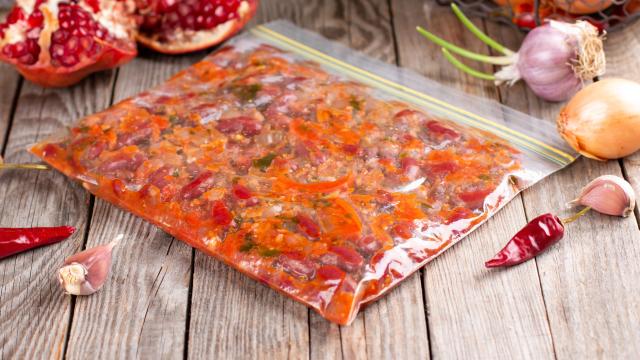Making a big batch of Sunday sauce, curry, or a giant pot of chili is taxing. Recipes require large quantities of ingredients, the process can be a multi-hour or all-day endeavor—and for what? Oh, right, you get 10-20 servings of richly flavored sauce that has been made with love and patience. It’s worth it to ensure every drop gets used, so put technology to use and freeze the majority of it. Here’s how to freeze large quantities of sauce for easy dinners later.
Freeze smarter
The biggest hurdle with freezing anything—sauce, broth, or even meat—in large blocks is that thawing a small part of it is a true pain in the ass. You either have to thaw the entire thing and refreeze it, which can negatively impact the quality, or hack it apart, which can be dangerous.
Instead, address the portion size before you freeze the sauce the first time. You may have heard of using ice cube trays for portioning sauce in an adorable way. While it’s important for everyone to discover what works for them (and this might work for you), for me, the ice cube tray is a garbage idea. For one thing, it’s way too small. My ice cube divots hold one tablespoon of water each. I’d need at least half the tray for one small bowl of pasta. I’m also relatively sure those trays will be imbued with tomato, garlic, or basil smell afterward, which means I can’t use them for ice ever again, and I’m not the type of person who wants to keep sauce-specific ice cube trays in my home. Instead of ice cube trays, use something more realistic to a real serving size.
Choose your “single serving” size
Ice cube trays can work for freezing potent, powerful liquids—like lemon juice, or olive brine—where you’re likely to just use a bit. For large batches of sauce, portion the servings in plastic reusable containers or bags. The size should match the “single” serving you will likely need. If you have a family of five, you’ll freeze larger portions than a two-person household. Use appropriately sized freezer bags or reusable containers accordingly.
Sheet trays are indispensable tools for flat freezing:
When in doubt, freeze flat
Arranging my freezer is like a terrifying puzzle sometimes. I know there’s a way to fit it all, but there are so many irregular shapes in there. Freezing liquid flat instead of in a block shape can help make storage easier. More importantly, you can break the sauce into pieces easily when it’s frozen thin and flat to adjust the portion size later. This is perfect if you’re not really sure how much you’ll need for dinner on any given night. Not only is freezing sauce quicker this way, but thawing and cooking will be faster too.
How to freeze large batches of sauce
There are two ways to do this: Pre-portion sauce into bags, or use the sheet tray method.
- Pre-portioning with freezer bags: Simply dump your “single serving” into the freezer bag, around one to four cups. Lay it flat on a sheet tray and put it in the freezer until frozen solid. You can probably fit a few bags on one tray if you need to. Then neatly stack the frozen sauce bags.
- The sheet tray method. To consolidate even more slabs, you’ll use the sheet tray slightly differently. Line a sheet tray with parchment paper or plastic wrap, with some overhang over the sides. Spread the sauce directly onto the tray, about a half-inch deep. Carefully put the sheet tray in the freezer so it doesn’t spill. Allow the sauce to freeze, probably 30 minutes to an hour depending on the type of sauce and its thickness. Take it out of the freezer and use the liner to lift and help break the sauce into smaller slabs. Slide the slabs into freezer bags or other containers.
Even if you’re an ice cube tray portioner for life, you can still consolidate your cubes into a bag or container if that helps with your freezer tetris. When you’re ready for a zero-effort slow-simmered sauce on a time-crunched weeknight, simply drop a slab or two of sauce into a pot along with some frozen rice and a tablespoon of water (to prevent burning). Cover it with a lid and put it on low heat. Let it heat up on its own for 20 minutes while you take some time to yourself to unwind.

Leave a Reply
You must be logged in to post a comment.